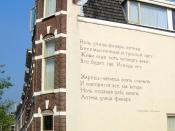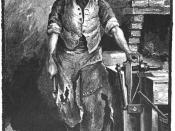In 1913 Guillaume Appolinaire's "Alcools" was published. It marked a watershed in French, indeed world, literature, and is heralded by the Encyclopaedia Britannica as Appolinaire's "poetic masterpiece". The poem featured on this course, 'Hôtels', was included in this highly original, innovative and influential collection. 'Hôtels' combines traditional verse forms with truly modern imagery to great effect, and through this merits its place in this celebrated poetic collection.
The traditional element can be noted in the structure of the poem. Here is a poem of six stanzas, of four lines each and with the with a simple 'abab cdcd efef ghgh ijij klkl' rhyming scheme. The traditional rhyming scheme lulls the reader into a false sense of security, the simplicity of the rhythm created is somehow diverged by the striking use of modern imagery, and the groundbreaking theme of the poet/peasant complex. The poem is almost at odds with itself, and thus, highlights the dichotomy between the world of poetry and the world of the "Hôtel".
Furthermore, the poem sits very tidily on the page, and is not visually striking to the viewer. This is a clever device utilised by Appolinaire which leads the reader to believe that the poem will follow a conventional theme, and thus, allowing Appolinaire's salient theme and avant-garde use of modern imagery have a more significant effect on the reader.
This modern use of imagery is clearly noted in the poem's first section, and creates a listless, tired mood. The metaphor of the 'veuve' in the first line sets up an uneasiness in the reader. The room of the hotel is personified. However, a widow derives connotations of loss, grief and remorse which evokes in the reader an atmosphere of pain, suffering and hopelessness. The 'presence neuve' although a presence is an empty one, which is in itself almost more isolating than complete solitude. This gives the poet an anxious and uneasy presence in the poem. Appolinaire uses this unease to great effect later the poem, notably when he describes his voisin as 'laid'. The acrid smoke creates a pungent and unpleasant scene, it can be seen by the reader as seeping and percolating throughout the sordid world of the hotel . The distant noise of traffic emphasises the poet's detachment from the macrocosm of the exterior world and adds a auditory element to the poem. It also acts as a reminder to the reader to the extent of the isolation of the poet when he does in fact, "ferme son porte". The opposing microcosm is to be found in the poet's own room, in his "seul amour", the world of art and poetry. The fourth stanza adds a lethargic, nihilistic character to the poem, "La Vallière". This adds a sexual element, "Qui boite et rit", which emphasises the squalid, sleazy and seedy atmosphere. The "Babel" languages image although appears to be a positive image of diversity, suggests a further isolation. The final stanza reinforces the notion of the secluded poet, "Fermons nos Portes à double tour Chacun apporte Son seul amour". The "seul amour" underscores the central image of the poem, the isolated poet, who finds his only love in the world of words he creates.
Thematically, "Hôtels" is far from traditional. It is concerned with the poet/peasant complex and the loneliness and isolation of the poet in society. The poem depicts a man, stranded in a world of isolation, separation and seclusion. The world of the Hotel is harsh and unforgiving, those around him do not pay him any heed, "Mon voisin laid Qui fume un âcre Tabac anglais". Although isolated, the poet finds solace in his "seul amour", poetry. The "babel" languages that surround the poet are suggestive of a language and a means of interaction that is foreign to the poet. It also seems that Appolinaire wishes to give emphasis to the irony he saw in the world he lived in, that is, a society where appreciation is reserved for the peasant and suspicion for the poet who is, in a sense, banished and forced to exist on the periphery, this suspicion is evident in the lines "Le patron doute Payera-t-on ".
The atmosphere created in the poem is one of urban squalor and dilapidation. The ugliness of the grubby world of the Hotel is emphasised by the physical description of the neighbour "Mon voisin laid". The action of smoking is a very visual image, an image associated with intoxication and poisoning. It suggests and underscores the hopelessness and despair of the artless world which the poet sees around him, and its ability to affect and infect those who dwell in it. The atmosphere is nihilistic and despondent, the people of the hotel are depicted in an unsightly and repulsive way, that together they know many "langues", and yet are unable to communicate. The mood is lonely, lethargic and listless. This serves as a contrast to the world of the poet, his "seul amour" which gives him comfort and warmth in a harsh, guileless and artless world. The world of the poet is of "amour" and yet it is "son" world. This emphasises the isolation of the poet, the seclusion. Is also sets him apart from the other inhabitants of the world of the hotel, and indeed the world of traffic which continues to exist without him, by saying it is a personal world, dear to the poet's heart.. Nevertheless, the atmosphere is inconsistent, at the beginning of the poem it is one of pain, isolation and loneliness, however, in the final stanza it develops into an atmosphere of hope, hope in a self-created world of art and poetry. This change in atmosphere enriches the reader's enjoyment of the poem, it serves to toy with the emotions of the reader, and bring them on an emotional journey with the poet.
"Hôtels", although almost one hundred years old, is a poem that does not look nor sound old-fashioned. The dichotomy between a modern world and a world of technology still strikes a chord in today's reader. "Hôtels" through its originality in literary technique remains a fascinating read for a student of French Literature, or anyone else for that matter. The poem juxtaposes the old and the new, using traditional forms and modern imagery, and as such is wholly deserving of our attention.




